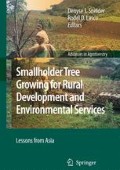Abstract
Dudukuhan are traditional tree farming systems in West Java, Indonesia and can be divided into four types: (1) timber systems, (2) mixed fruit-timber-banana-annual crop systems, (3) mixed fruit-timber systems, and (4) fallow systems. Traditionally dudukuhan are managed on an extractive basis, with few inputs (quality germplasm, fertilizers, labor, etc.) allocated to maintain or improve system productivity. Farmers favour this management approach because of limited land tenure, small landholding size, off-farm employment opportunities, limited market access, or their limited experience with intensive tree management. Depending on the socioeconomic conditions and market opportunities the management of a specific piece of land may shift between the four types of dudukuhan. This transformation occurs gradually over a number of years and affects the tree diversity and total number of trees in the system. A desire for tree products, market opportunities, and land tenure status are the key factors that influence farmers’ decision concerning which type of dudukuhan to develop. Positive changes in these factors have a positive influence on tree diversity and tree density. Income generation is the primary factor influencing farmers’ choice of tree species. Soil conservation is a secondary but important factor influencing both choices of dudukuhan and tree species. Farmers are interested in intensifying the management of their dudukuhans, but hesitate because they do not know where to focus their efforts. Experience indicates that Nanggung farmers may be best served by transforming their traditional subsistence tree farming systems into semi-commercial enterprises that yield products to meet both home and market demand.
Access this chapter
Tax calculation will be finalised at checkout
Purchases are for personal use only
Preview
Unable to display preview. Download preview PDF.
References
Budidarsono, Wijaya SK and Roshetko JM (2004) Farm and Household Economic Study of Kecamatan Nanggung. A Socio-economic Baseline Study for the Agroforestry Innovations and Livelihood Enhancement Program. World Agroforestry Centre – ICRAF, Bogor (unpublished)
Carandang WM, Tolentino EL and Roshetko JM (2006) Smallholder tree nursery operations in southern Philippines - supporting mechanisms for timber tree domestication. Forests, Trees and Livelihoods 16: 71–83
De Foresta H, Kusworo A, Michon G and Djatmiko WA (2000) Ketika Kebun Berupa Hutan: Agroforest Khas Indonesia Sebuah Sumbangan Masyarakat. (When tree gardens become forests: Traditional Indonesian agroforestry a contribution to communities). International Centre for Research in Agroforestry, Bogor, Indonesia, p249
De Foresta H, Michon G, Kusworo A and Levang P (2004) Damar Agroforest in Sumatra, Indonesia: Domestication of a Forest Ecosystem through Domestication of Dipterocarps for Resin Production. In: Kusters K and Belchers B (eds) Forest Products, Livelihoods and Conservation. Case Studies of Non-Timber Forest Product Systems, Vol 1. Center for International Forestry Research, Bogor, Indonesia
Fernandez CG (2004) Benzoin, a Resin Produced by Styrax trees in North Sumatra Province, Indonesia. In: Kusters K and Belchers B (eds) Forest Products, Livelihoods and Conservation. Case Studies of Non-Timber Forest Product Systems, Vol 1. Center for International Forestry Research, Bogor, Indonesia
Michon G and de Foresta H (1995) The Indonesian Agroforest Model. Forest Resource Managemant and Biodiversity Conservation. In: Halladay P and Gilmour DA (eds) Conserving Biodiversity Outside Protected Areas. The Role of Traditional Agro-ecosystems. IUCN, p90–106
Potter L and Lee J (1998) Tree Planting in Indonesia: Trends, Impacts and Directions. CIFOR Occasional Paper No 19
Predo CD (2002) Bioeconomic Analysis of Land Use Options for Grassland Areas in Claveria, Misamis Oriental, Philippines. Leyte State University, Leyte, The Philippines
Roshetko JM, Fay C, Budidarsono S, Tukan J, Nugraha E, Pratowo N and Manurung G (2004) Agroforestry Innovations and Livelihood Enhancement in West Java. Final Report. The World Agroforestry Centre (ICRAF), Winrock International and The Indonesia Institute for Forest and Environment (RMI), Bogor, Indonesia, January 2003–September 2004, 45p
Roshetko JM, Nugraha E, Tukan JCM, Manurung G, Fay C and Van Noordwijk M (2006) Agroforestry for Livelihood Enhancement and Enterprise Development. Paper Presentation at the International Workshop on Integrated Rural Development in East Nusa Tenggara Province. Kupang, East Nusa Tenggara, Indonesia, 5–7 April 2006
Sheil D, Puri RK, Basuki I, Heist Mv, Syaefuddin, Rukmiyati, Sardjono MA, Samsoedin I, Sidiyasa K, Chrisandini, Permana E, Angi EM, Gatzweiler F, Johnson B and Wijaya A (2002). Exploring Biological Diversity, Environment and Local People’s Perspective in Forest Landscapes. Methods for a Multidisciplinary Landscape Assessment. Center for International Forestry Research, Bogor, Indonesia
Smith RL (1990) Elements of Ecology. 2nd edition. West Virginia University. Harper & Row, New York
Suzuki E, Yoneda M, Simbolon S, Muhidin A and Wakiyama S (1997) Establishment of Two 1-ha Permanent Plots in Gn. Halimun National Park for Study of Vegetation Structure and Forest Dynamics. In: The Inventory of Natural Resources in Gunung Halimun National Park. Research and Conservation of Biodiversity in Bogor, Indonesia, Vol II, JICA-PHPA-LIPI
Author information
Authors and Affiliations
Corresponding author
Editor information
Editors and Affiliations
Rights and permissions
Copyright information
© 2008 Springer Science + Business Media B.V
About this chapter
Cite this chapter
Manurung, G.E.S., Roshetko, J.M., Budidarsono, S., Kurniawan, I. (2008). Dudukuhan Tree Farming Systems in West Java: How to Mobilize Self-Strengthening of Community-Based Forest Management?. In: Snelder, D.J., Lasco, R.D. (eds) Smallholder Tree Growing for Rural Development and Environmental Services. Advances in Agroforestry, vol 5. Springer, Dordrecht. https://doi.org/10.1007/978-1-4020-8261-0_4
Download citation
DOI: https://doi.org/10.1007/978-1-4020-8261-0_4
Publisher Name: Springer, Dordrecht
Print ISBN: 978-1-4020-8260-3
Online ISBN: 978-1-4020-8261-0
eBook Packages: Biomedical and Life SciencesBiomedical and Life Sciences (R0)

